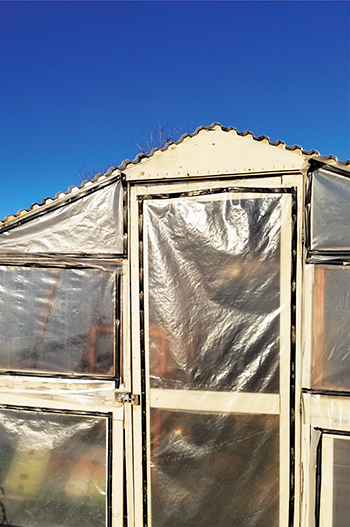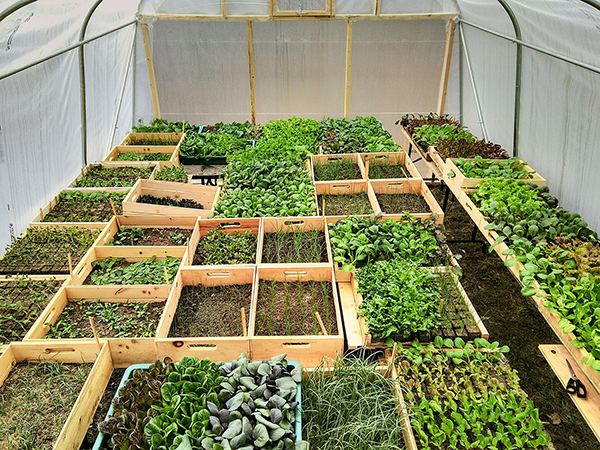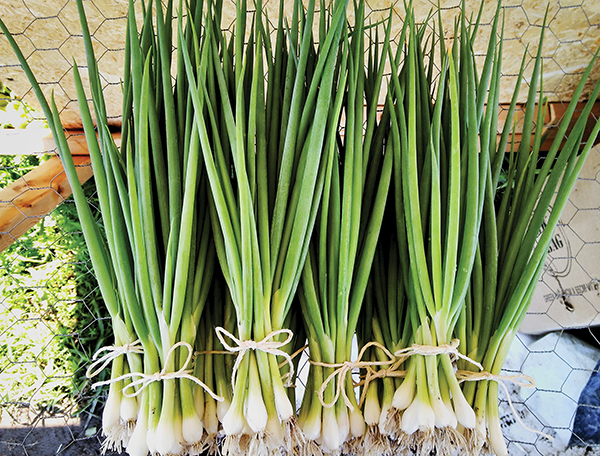Growers share what’s working for them
We asked growers how they were reducing plastic on their farms. You shot back with ideas and alternatives to petroleum-based products large and small. Obvious in your replies and interviews was an impassioned dedication to the Holy Grail of zero plastic. We sensed your guilt about the plastic remaining in your farming operations. Yet, today we focus on progress and move forward creatively and collectively.
Soil blocks are popular
Let’s begin where the plants start: seedlings and transplants. Most of us have handled the flimsy plastic seeding trays that easily tear and smash. Racing Heart Farm in Colfax, Wisconsin, told us: “We have old plastic trays, which we will use until they become garbage.” They are replacing them with Small Farm Works’s non-chained paper pots and cautioned: “A 128 paper pot holds a lot more soil than the same of plastic because there is no air space, it’s more like growing in a 72.” Foggy Top Farm in Bolinas, California, is replacing plastic pots with composted cow manure CowPots that are planted in the field. Others opt for the durable Winstrip trays.
 California farmer Sean Mooney uses old drip tape as batten when stapling on greenhouse plastic. Photo by Sean Mooney.
California farmer Sean Mooney uses old drip tape as batten when stapling on greenhouse plastic. Photo by Sean Mooney.
However, many of you praised soil blocks made with metal block makers and set in wooden boxes. Colton Stuart in Maine recommends Eliot Coleman’s and Jim Kovaleski’s soil block tutorials on YouTube.
Jennie Videto and Chris Lambert at Catena Farm in Shawville, Quebec, built 8-foot by 4-foot wooden tables filled with about 4 inches of sand to set the blocks on. Wet sand spreads the heat in lieu of plastic heating pads. They wind and shallowly bury Hydrofarm soil heating cable in the sand with six inches between pieces of wire and then add a bit more sand over it.
“The wire with coating of plastic is still a tiny bit of plastic,” Jennie said cringing. Because they don’t own the land, they line the boxes with old plastic to keep sand from falling through cracks. This way, they can dismantle the tables and move them one day to a permanent farm site and then seal the bottoms.
Rain Dance Organic Farm north of Ann Arbor, Michigan, sells soil block seedlings in pre-set collections with a map of plants. Sandi Eugenia at footnote farm in Chapel Hill, North Carolina, said since the blocks stay firm, she sells customized orders labeled with paper clips and pieces of old mini blinds. Two Trees Farm in Canton, North Carolina, sells plant starts in pots and asks customers to return them so they can sort, sterilize and reuse them. “It takes a long time, and does not save us any money really, but it reduces the plastic we send into the world.”
 Catena Farm in Quebec uses soil blocks and wooden boxes. Photo courtesy of Jennie Videto.
Catena Farm in Quebec uses soil blocks and wooden boxes. Photo courtesy of Jennie Videto.
They get about half the pots back without offering incentives. That was a repeated theme that customers don’t fully comply with requests to return containers or bring their own for markets or CSAs. Kidder Gowen, who helped establish a zero-waste committee on Aquidneck Island, Rhode Island, where her Hawk & Handsaw Farm is located, continually educates customers about packaging in farm newsletters, social media and interactions to help them take more responsibility.
Many of you use wooden labels (sometimes from craft stores) for plants. All the plastic bags that potting soils and amendments come in disturbed many of you. So, you started producing your own compost, liquid fertilizers, and like Sara Tekula and others, your own activated biochar.
Those who can, buy in greater volumes. Brooklyn Grange Farm, which grows on 5.6 acres on rooftops in Brooklyn and Queens, switched from pallets of bagged soil to ordering it by the yard. “It was a lot of plastic we were going through” said Liz Dowd, Director of Farming Operations. “It’s a little inconvenient. Bags of soil were easier to move where we needed them.” They move soil up freight elevators. The idea came from an annual audit of single-use plastics during which Brooklyn Grange measures how much waste is going into landfills or compost.
 Catena Farm in Quebec uses natural jute to bunch produce. Photo courtesy of Catena Farm.
Catena Farm in Quebec uses natural jute to bunch produce. Photo courtesy of Catena Farm.
In the field
“No-till cuts down on weeds so we don’t use plastic mulch in the field,” wrote Green Things Farm Collective in Ann Arbor, Michigan. No-till farms reported using leaves, straw, cardboard and coffee bean bags as mulch.
Hawk & Handsaw blankets beds and pathways with cardboard to suppress weeds and improve the soil as it breaks down. They regularly hit up the local resource recovery station for used cardboard. “They know us as the crazy farmers and we load up our vehicles with as much cardboard as we want from their constant supply,” Gowen said. They get free wood chips from tree service companies to cover the cardboard. “We have so much mycelia growth in our beds and paths that we were inspired to intentionally inoculate our paths and some of our perennial beds with oyster and wine cap mushrooms this year.”
I used to collect cardboard from dumpsters behind bicycle shops. The large boxes had no stickers (they must be removed) and only three metal staples to take out. Brooklyn Grange has replaced some of its plastic mulch with cocoa husks, a byproduct from local chocolatiers that slowly leaches nitrogen into the soil.
JSM Organics in Royal Oaks, California, is trialing a biodegradable film mulch (Organix A.G. Film also called Ecovio®). Owner Javier Zamora said the film mulch went down in November in strawberry rows and is holding up well. “By August at the latest it will be clear whether it will be viable,” Zamora said.
Viable means it doesn’t break down too quickly and fail to control weeds, retain water and modulate soil temperature. Biodegradable mulch standards require 90 percent degradation within two years. Neither Organix A.G. Film nor the other well known biodegradable film mulch, BIO360, are completely biologically based; Most films are about 60 percent bio-based and contain synthetic petroleum-based ingredients while still meeting the standards for biodegradability.
Pam Krone, Agricultural Water Quality Coordinator at the California Marine Sanctuary Foundation, is monitoring the trial at JSM Organics and other farms in conjunction with Washington State University. She said the film is eaten by soil microbes and current research shows no negative soil impacts. “Hopefully they’ll get to a 100 percent bio-based film,” said Krone, who works hard to keep agricultural plastics out of waterways and oceans.
Current USDA organic certification rules don’t allow farms to till in mulch films with petroleum elements at the end of the season, so Zamora’s crew will remove it. Europe and Australia allow biodegradable mulch films with a percentage of petroleum, but are requiring manufacturers to incrementally reduce the amount of petroleum.
Weed Guard Plus is a 100 percent bio-based, USDA certified mulch made of paper. GFM Publisher Andrew Mefferd is going to try it out this coming season.
Many farmers told us they use and reuse cattle panels instead of Hortonova trellising. Fortitude Farm, in Bakersfield, California, said: “They last forever it seems. We use them for beans, peas, cucumbers, any vining veggies and flowers.”
Jennifer Davenport at Sweet Leaves Farm in Ohio shared a 1997 report on trials of woolen floating row covers in New Zealand that showed significantly fewer slugs and higher and less variable temperatures. I contacted the lead researcher who told me it never made it to a commercial product. I’ll keep an eye out.
Often drip lines are dotted with couplers to stem leaks. Farmer Sean Mooney in Kelseyville, California, came up with clever uses for old drip tape. “When our drip tape is a few years old and emitters get clogged beyond use, we used them to trellis our tomatoes like it was string. [You’ve] got to get it tight to prevent sagging as it will expand in the heat. Able to get another few years of use.” Mooney also employs them as batten tape when stapling greenhouse plastic to wood-framed end walls.
Old drip tape sometimes can be recycled. Krone said in California manufacturers Delta Plastics and Netafim pick up and recycle it from large farms. For small farms, the municipal waste facility in Yolo County, California, will separate it and aggregate it for manufacturer recycling. Monterey County is trialing collecting it. Farmers might urge local recycling operations to do the same.
Josh Volk at Slow Hand Farm suggests using the absolute lightest material to reduce plastic use. “As an example, you basically have to get 2.5x the life out of 15mil drip to make it a better option than 6mil.” Brooklyn Grange is incrementally switching to durable Rivulis drip lines. “We’re thinking long game, it’s not an investment we can make in one year,” Dowd said. Catena Farm opted for a durable overhead system (Dubois Agrinovation Wobbler). To reduce water waste they run it on a very nuanced schedule according to specific crop needs and wind interference.
 Hawk & Handsaw Farm in Rhode Island blankets new beds and pathways with cardboard as part of its no-till methods. Photo courtesy of Kidder Gowen.
Hawk & Handsaw Farm in Rhode Island blankets new beds and pathways with cardboard as part of its no-till methods. Photo courtesy of Kidder Gowen.
As you may imagine, no one suggested alternatives for hoop and greenhouse plastics (although they reuse old pieces). There don’t seem to be substitutes on the horizon. Some farms opt not to use them, but for many farms, especially in cooler climates, that’s not a sustainable option.
Packaging for sales
Zamora said JSM Organics’ main plastic sources are field mulch and packaging. Three years ago he replaced plastic clam shells and mesh pint containers with ReadyCycle® home compostable paperboard boxes. He uses them for strawberries, blueberries, raspberries, blackberries and tomatoes.
He made the switch despite the fact that cardboard clamshells cost more than four times what plastic ones do. “I felt like it was the right thing to do based on what the customers were asking for,” said Zamora. “Even though it’s really expensive, it has also brought me new customers because people see that packaging and want it. It will pay back in the future in both business and the environment.”
At the mention of biodegradable clear containers, Gowen jumped in to explain that biodegradable containers containing PLA (polylactic acid) stamped with #7 need high heat and time to break down and they are not accepted at many compost centers. “When we looked into this option our facility told us they do not accept compostable plastic (and this is starting to be more consistent across the industry as a whole) because of the low nutritional value these plastics bring to compost and increased contamination due to confusion by consumers,” Gowen wrote. Confused consumers throw them in with other recyclable plastics. “So compostable plastics may seem like a quick easy fix to this problem but in reality is still just another problem.”
Some sites accept PLA plastics. The Green Anarchist in Annapolis, Maryland, specializes in microgreens and Annapolis Compost takes their Good Start Packaging® PLA clamshells. Not so in Virginia where Haywoodle Farm grows salad mixes, braising greens and microgreens. Stephanie and Michael Raphael learned compost sites don’t take them after they bought loads of compostable clamshells. They got customers to return them and composted them on their farm by shredding the PLA containers and churning it in hot heaps of wood chips. They added the compost to ornamental beds. Haywoodle Farm switched to BOTTLEBOX® containers made of number #1 PET plastic that can be recycled repeatedly.
The Raphaels are enthusiastic participants in the Precious Plastics Community, www.preciousplastic-usa.com/, a global network addressing the scourge of plastic. They plan to create a workshop to 3-D print useful items from plastic trash. “We encourage customers to recycle with us, they can even bring us containers from other farms or grocery stores,” Stephanie said.
Living Web Farms in Mill River, North Carolina, runs a robust on-farm recycling program featured in a series of excellent videos, Plastics Workshop, Tools for Recycling and Managing Waste and more (go to livingwebfarms.org to find their videos).
Fortitude Farm personalizes reusable totes for CSA members. Green Things Farm packs orders into bulb crates that customers leave and offers a CSA by the pound instead of bunches, saving time and packaging. Catena Farm packs baby greens in paper bags (logos with soy-based ink) and bunches produce with jute twine. Hawk & Handsaw leaves salad mixes loose and pushed to one corner of customers’ produce bins, which are repurposed fish tubs sanitized after single use at a local fish market.
Many of you moved toward bulk or no packaging for produce. Then, COVID forced more individually packed servings for safety. Certified home compostable bags include Crown Poly (tinyurl.com/4n7f3kcd) and BioBag (tinyurl.com/3esww7fu) which work better with dry produce. The Biodegradable Products Institute certifies packaging for commercial composting and is developing a certification for home compostable products.
Bags and packaging that contains additives such as P-Life that make plastics degrade cause plastic to break down into fragments that pollute, and they do not degrade under all conditions. Further, if put in with recycling they render plastic unrecyclable. Recyclers, the plastics industry and environmental groups oppose use of products with these additives. We will continue to revisit packaging issues.
Flowers
For farmers markets, flower CSAs or bouquets sold at retailers, many of you use kraft paper (a compostable lumber industry by-product) or natural jute twine and reuse and swap out containers such as mason jars for regular customers. For more sophisticated designs, when I worked with Jane Henderson at Commonwealth Farms in Concord, North Carolina, we had disdain for Oasis® floral foam — plastic synthetic blocks containing formaldehyde that never decompose and are ubiquitous in the conventional floral industry. We often arranged the base greenery stems to provide shaping support, used floral frogs (spikes at the bottom of containers) and also put sand or chicken wire in containers as substitutes for floral foam.
Susan McLeary, who teaches and writes about floral design after a long tenure designing for weddings and events, is on a mission to test and preach about non-plastic approaches. She posts ideas on her popular Instagram feed under Passion Flower Sue. The key, she says, is to choose floral materials that stand up well and pre-hydrate flowers and other elements. Here are links to McLeary’s reliable floral materials tinyurl.com/2jtkvwma and hydrating method tinyurl.com/2jjerzsw. She suggests investing in event structures that have water receptacles built in and that can be used indefinitely.
“I had a welder build a chuppah [canopy for Jewish weddings] that can be reshaped into other structures,” McLeary said. “I’ve used it over the last ten years.” Similarly, she advises investing in opaque vases or vessels that you love.
Recently, she posted using snow fungus as support in containers, but said it’s too early to tell if works well. In another, she collected pine needles and trimmed them to fit tightly in a vessel and slid in stems that remained erect. The reusable chicken wire that is often a base in her arrangements is coated with plastic because it’s more malleable. In large installations, she stuffs the chicken wire with scavenged foliage for support and moisture.
McLeary’s friend Tobey Nelson, of Sustainable Floral Design in Washington State, also is tackling plastics. Nelson offered her take on Agra-Wool International’s floral foam substitute made from basalt and cane or beet sucrose. “While rock may be better than plastic from a pollution and toxicity perspective, it is still not a renewable resource,” Nelson said. “Perhaps that is less offensive than if the rock is mined specifically for Agra Wool [it’s a byproduct], but one could counter that it is still lightly supporting the mining industry. My bigger concern is that if we get too happy with Agra-Wool as The Floral Foam Substitute, it will mollify the demand from consumers to have a more innovative substitute that is made 100 percent from renewable resources.”
Nelson points to the need to influence manufacturers. Reducing plastics on farms also means lobbying for changes such as Extended Producer Responsibility laws on the state and federal level. We welcome your continued input so we can return to this issue again.
Do you have a way of reducing or eliminating plastic on your farm that would be helpful to other growers? Share it with us in a direct message on social media or email us and we’ll share it in a future article.
Jane Tanner grew cut flowers and specialty crops at Windcrest Farm and Commonwealth Farms in North Carolina, and helped manage the biodynamic gardens at Spikenard Farm in Virginia.

